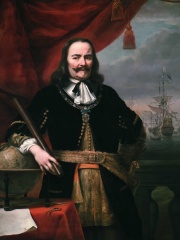
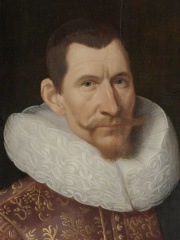
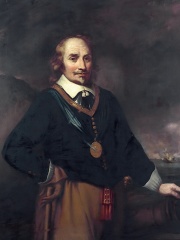
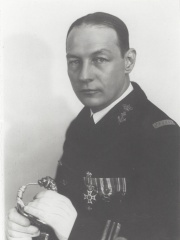
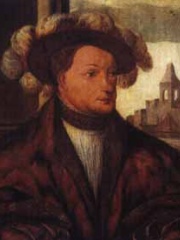
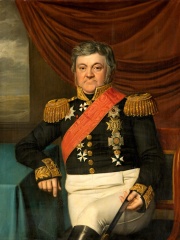
The Most Famous
MILITARY PERSONNELS from Netherlands
This page contains a list of the greatest Dutch Military Personnels. The pantheon dataset contains 2,058 Military Personnels, 7 of which were born in Netherlands. This makes Netherlands the birth place of the 37th most number of Military Personnels behind Lithuania, and Syria.
Top 7
The following people are considered by Pantheon to be the most legendary Dutch Military Personnels of all time. This list of famous Dutch Military Personnels is sorted by HPI (Historical Popularity Index), a metric that aggregates information on a biography's online popularity.

1. Michiel de Ruyter (1607 - 1676)
With an HPI of 72.70, Michiel de Ruyter is the most famous Dutch Military Personnel. His biography has been translated into 43 different languages on wikipedia.
Michiel Adriaenszoon de Ruyter (IPA: [miˈxil ˈaːdrijaːnˌsoːn də ˈrœytər]; 24 March 1607 – 29 April 1676) was a Dutch States Navy officer. His achievements with the Dutch navy during the Anglo-Dutch Wars earned him the reputation as the greatest naval commander of 17th century Europe. De Ruyter came from a modest background in Zeeland and began seafaring from an early age; by the age of 30 he had become a shipmaster in the Dutch merchant fleet. In 1641, De Ruyter briefly served as a rear admiral during the Portuguese Restoration War, after which he returned to a prosperous merchant career for a decade before retiring to his hometown of Vlissingen. On the outbreak of the First Anglo-Dutch War in 1652, De Ruyter accepted a command in the Dutch Navy under lieutenant admiral Maarten Tromp, distinguished himself and was promoted to vice admiral at the end of the war. In 1655, he took part in the Second Northern War on the side of Denmark-Norway against Sweden. De Ruyter was named lieutenant admiral and commander of the Dutch fleet at the start of the Second Anglo-Dutch War in 1665, and in 1666 he won a hard-fought victory in the Four Days' Battle in the southern North Sea. In 1667, De Ruyter executed the highly successful Raid on the Medway, where he destroyed much of the English fleet and captured the English flagship HMS Royal Charles, facilitating a favourable peace for the Dutch. In the Third Anglo-Dutch War, De Ruyter's actions during the battles of Solebay (1672), Schooneveld (1673), and Texel (1673) successfully prevented an invasion of the Dutch coast by Anglo-French forces. Continuing his fight against the French, De Ruyter was fatally wounded by a cannonball at the Battle of Augusta off Sicily in 1676, and died a week later in Syracuse. His body was brought back to Amsterdam, where he was accorded a state funeral and interred in the Nieuwe Kerk. Often dubbed a Dutch folk hero, De Ruyter was highly respected by his sailors and soldiers, and his nickname Bestevaêr (early modern Dutch for "grandfather") is still used to refer to him in Dutch media today. Several Royal Netherlands Navy vessels have been named after him and his flagship, and he is credited as a founder of the Netherlands Marine Corps.

2. Jan Pieterszoon Coen (1587 - 1629)
With an HPI of 66.34, Jan Pieterszoon Coen is the 2nd most famous Dutch Military Personnel. His biography has been translated into 22 different languages.
Jan Pieterszoon Coen (Dutch pronunciation: [jɑn ˈpitərsoːŋ ˈkun]; 8 January 1587 – 21 September 1629) was a Dutch naval officer of the Dutch East India Company (VOC) in the early 17th century, serving two terms as governor-general of the Dutch East Indies. He was the founder of Batavia, capital of the Dutch East Indies. Renowned for providing the impulse that set the VOC on the path to dominance in the Dutch East Indies, he was long considered a national hero in the Netherlands. Since the 19th century, his legacy has become controversial due to the brutal violence he employed in order to secure a trade monopoly on nutmeg, mace and cloves. He led the final Dutch conquest of the Banda Islands in 1621, which culminated in the Banda massacre, which saw 2,800 Bandanese killed and 1,700 enslaved by the Dutch. This is regarded as an act of genocide and earned him the nickname of 'Butcher of Banda'. A famous quote of his from 1618, Despair not, spare your enemies not, for God is with us, illustrates his single-minded ruthlessness, and his unstinting belief in the divinely-sanctioned nature of his project. Using such self-professed divine sanction to violently pursue his ultimate goal of a trade monopoly in the East Indies, Dutch soldiers acting on Coen's orders perpetrated numerous wanton acts of destruction in the spice islands of (now) eastern Indonesia, including the infamous Banda Massacre of 1621. The purpose of this was to gain a monopoly upon the supply of nutmeg and mace in order to sustain artificially high prices and profits for the Dutch investors in the VOC. This was deemed by many to be excessive, even for such a relatively violent age. Consequently, since Indonesia became independent he has been looked at in a more critical light, and historians view his often violent methods to have been excessive.

3. Maarten Tromp (1598 - 1653)
With an HPI of 65.39, Maarten Tromp is the 3rd most famous Dutch Military Personnel. His biography has been translated into 26 different languages.
Maarten Harpertszoon Tromp or Maarten van Tromp (23 April 1598 – 31 July 1653) was an army general and admiral in the Dutch navy during much of the Eighty Years' War and throughout the First Anglo-Dutch War. Son of a ship's captain, Tromp spent much of his childhood at sea, during which time he was captured by pirates and enslaved by Barbary corsairs. In adult life, he became a renowned ship captain and naval commander, successfully leading Dutch forces fighting for independence in the Eighty Years' War, and then against England in the First Anglo-Dutch War, proving an innovative tactician and enabling the newly independent Dutch nation to become a major sea power. He was killed in battle by a sharpshooter from an English ship. Several ships of the Royal Netherlands Navy have carried the name HNLMS Tromp after him and/or his son Cornelis, also a Dutch admiral of some renown.

4. Karel Doorman (1889 - 1942)
With an HPI of 63.69, Karel Doorman is the 4th most famous Dutch Military Personnel. His biography has been translated into 20 different languages.
Karel Willem Frederik Marie Doorman (23 April 1889 – 28 February 1942) was a Royal Netherlands Navy officer who during World War II commanded remnants of the short-lived American-British-Dutch-Australian Command naval strike forces in the Battle of the Java Sea. He was killed in action when his flagship HNLMS De Ruyter was torpedoed during the battle, having chosen to go down with the ship.
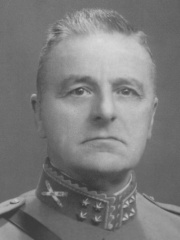
5. Henri Winkelman (1876 - 1952)
With an HPI of 62.94, Henri Winkelman is the 5th most famous Dutch Military Personnel. His biography has been translated into 22 different languages.
Henri Gerard Winkelman (17 August 1876 – 27 December 1952) was a Dutch military officer who served as Commander-in-chief of the Armed forces of the Netherlands during the German invasion of the Netherlands.

6. Charles II, Duke of Guelders (1467 - 1538)
With an HPI of 62.35, Charles II, Duke of Guelders is the 6th most famous Dutch Military Personnel. His biography has been translated into 18 different languages.
Charles II (9 November 1467 – 30 June 1538) was a member of the House of Egmond who ruled as Duke of Guelders and Count of Zutphen from 1492 until his death. He had a principal role in the Frisian peasant rebellion and the Guelders Wars.

7. Lodewijk van Heiden (1773 - 1850)
With an HPI of 59.97, Lodewijk van Heiden is the 7th most famous Dutch Military Personnel. His biography has been translated into 15 different languages.
Lodewijk Sigismund Vincent Gustaaf Reichsgraf van Heiden (German: Ludwig Sigismund Vinzent Gustav Reichsgraf van Heyden; Russian: Логгин (Логин) Петрович Гейден, romanized: Loggin (Login) Petrovich Geyden; 6 September 1773 – 17 October 1850) was a Dutch naval officer and Orangist who went into exile from the Batavian Republic and served in the Russian Navy. He ultimately became a Russian admiral and commanded a squadron of the Imperial Russian Navy in the Battle of Navarino (1827). He was the father of Fyodor Logginovich van Heiden.
People
Pantheon has 7 people classified as Dutch military personnels born between 1467 and 1889. Of these 7, none of them are still alive today. The most famous deceased Dutch military personnels include Michiel de Ruyter, Jan Pieterszoon Coen, and Maarten Tromp.
Deceased Dutch Military Personnels
Go to all RankingsMichiel de Ruyter
1607 - 1676
HPI: 72.70
Jan Pieterszoon Coen
1587 - 1629
HPI: 66.34
Maarten Tromp
1598 - 1653
HPI: 65.39
Karel Doorman
1889 - 1942
HPI: 63.69
Henri Winkelman
1876 - 1952
HPI: 62.94
Charles II, Duke of Guelders
1467 - 1538
HPI: 62.35
Lodewijk van Heiden
1773 - 1850
HPI: 59.97
Overlapping Lives
Which Military Personnels were alive at the same time? This visualization shows the lifespans of the 3 most globally memorable Military Personnels since 1700.

